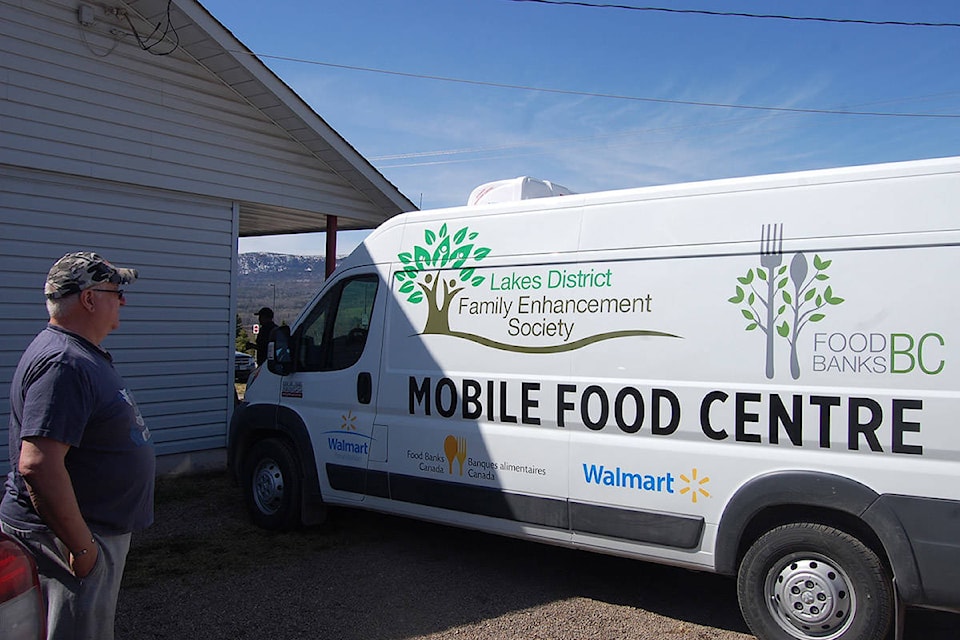Cartons of eggs, sticks of butter, and bags of flour are neatly arranged on the shelves of the mobile food bank — a cargo van equipped with a refrigeration unit to keep perishable goods at a consistent temperatures. There are repurposed recycling bins for bread, fruit and vegetables, and yellow milk crates filled with jars of peanut butter and cans of soup.
It’s the latest project of the Lakes District Food Bank — an initiative that’s meant to bring food to people struggling with poverty in rural areas surrounding Burns Lake.
The van was purchased with the support of some large charitable organizations. But now money is needed to keep it running.
Gratitude for service
“It’s all about access,” said Scott Zayac, executive director of the Lakes District Family Enhancement Society (LDFES), which runs the food bank.
The LDFES officially launched the mobile service on May 8, as part of a spring celebration at the food bank’s Centre Street location, which featured a community barbecue.
People experiencing poverty in far-flung locations face a special set of circumstances, having to improvise to get a ride into Burns Lake during the weekly distribution that happens between 10 a.m. and 1 p.m. on Tuesdays.
People often pay $20 for a one-way lift into Burns Lake from the ferry landing — a high price for people already struggling with poverty — while others take their chances hitchhiking, he said.
“That’s $20 that most people don’t have or can’t afford to spend on transportation,” said Zayac.
The vehicle itself is a Dodge Ram 3500 ProMaster cargo van with a six-cylinder gas engine.
It’s equipped with a refrigeration unit for the cargo area, which is lined with shelves built by Bruce Martens, a woodworker and retired millwright, who also serves as the volunteer driver.
He said it makes sense to centralize deliveries, rather than having a dozens of people travelling into Burns Lake.
And he said that people in communities such as Granisle have been astonished with the new service since it began last month. “The people are so grateful,” she said.
But he added that some people, including those living in smaller First Nations settlements on the Southside, may have trouble getting to central locations such as Grassy Plains.
Out-of-the-way deliveries
Since the beginning of April, the van has made deliveries every other Wednesday, alternating between communities south and west of Burns Lake.
Last month, there were two deliveries to Topley, Granisle and Tachet that served 64 individuals from 45 families during one April 18 delivery.
The van has also travelled twice to the Southside in April, providing food to 29 people from 16 families in Southbank and Grassy Plains on April 11.
The program is in a trial phase, it may expand if needed to include locations such as Endako, east of Burns Lake, or to make weekly deliveries, said Zayac.
Candice Little, the program administrator for the Lakes District Food Banks stressed people are welcome to send feedback about the schedule and location of deliveries.
“Our schedule is just in draft form right now,” she said, noting that people working for minimum wage often struggle with poverty but have trouble accessing services because they work full-time. “Our intention is to support people,” she said.
More reliable source of food
There’s also a food share program coordinated by Lakes Literacy that delivers food to the Southside, with food that comes from Save-On-Foods — formerly Overwaitea — and is delivered using the Words On Wheels (WOW) bus, a former school bus that serves as a library on wheels, in partnership with the Burns Lake library.
But the mobile food bank will help fill the gaps in that service, said Jennifer Peterson, who coordinates the food share program. “I think it’s fantastic,” she said, noting that food deliveries are only made using the WOW bus when donations are available at the grocery store.
That means that people wanting a loaf of bread sometimes go home empty handed — and she hopes the mobile food bank will be more reliable. “I’m sure it gives people some peace of mind, to have that security,” she said.
Rick Pooley, one of the board members of the LDFES, also said the refrigerated van is also better equipped for food deliveries. “A school bus isn’t set up to pack food,” he said. Zayac added that the pantry-style van provides more choice — people can select the food items they need and want.
Operating funds needed
The van is worth $60,000 and was purchased with funds from two organizations representing food banks — Food Banks BC and Food Banks Canada — and the Walmart Foundation, the charity wing of the multinational retail corporation.
But now a steady source of funding is needed to keep the program operating — that means paying for costs like gas, insurance and maintenance.
The driver is a volunteer — and indeed the food bank runs largely on volunteer energy, said Zayac. But the food bank hopes to make the van driver a staff position.
But all of that costs money, and the LDFES has estimated that with a paid driver, it will cost roughly $10,000 to make two deliveries a month in both directions — west and south — including the costs of food. “We need ongoing operational funding,” said Zayac.
